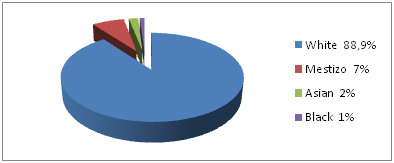Group U - Collaborative Climate Adaption Project: Difference between revisions
Jump to navigation
Jump to search
Evelinakny (talk | contribs) |
Evelinakny (talk | contribs) |
||
| Line 69: | Line 69: | ||
* Buenos Aires – is the destination for immigrants from Europe, particularly Italy and Spain. | * Buenos Aires – is the destination for immigrants from Europe, particularly Italy and Spain. | ||
* '''Racial diversity:''' | * '''Racial diversity:''' | ||
[[File: | [[File:Buen1.jpg]] | ||
=== Local Climate === | === Local Climate === | ||
Revision as of 18:26, 7 January 2013
| Area | Basin vega stream | |
| Place | Belgrano (CABA -Buenos Aires City) | |
| Country | Argentina | |
| Topic | Climate adaptation plan to the city, dealing with the high level of floods | |
| Author(s) | Evelina Knyzelyte, Teodora Morar, Graciela Spelzini | |
|
| ||
Rationale: Why have you selected this case study area?
- Buenos Aires is a vulnerable area that has developed on the basins of streams that has been piped underground. The city grew without an adequate infrastructure and with climate change,it has serious problems to face strong summer rains.
Authors' perspectives
- What theoretical or professional perspective do you bring to the case study?
Landscape and/or urban context
- Biogeography, land use patterns, cultural features, overall character, history and dynamics
- ratio of green/blue and sealed/built-up areas
Illustration: Map; sketches; short descriptive analyses
Cultural/social/political context
Cultural context:
- Buenos Aires from 1880 to 1930 became a multicultural city, ranked with the major European capitals.
- Sometimes the city is called the ‘Paris of South America’, with the highest concentration of theatres, radio, television and cinema.
- The inhabitants of Buenos Aires tend to consider themselves as different from the people of inland Argentina, more European in character rather than Latin American.
- Since the end of the 19th century, Porteños has come to be the name of the people from Buenos Aires. Porteños are generally extroverted, sophisticated, animated, and on the forefront of the latest trends and fashions, yet their attitudes are tinged with pessimism or fatalism about the direction of their country or the latest economic problems. Some Latin Americans have come to view porteñosas slightly arrogant or snobbish.
- Buenos Aires has a long tradition in visual arts, and it hosts many the most important art galleries. It is also very active in the street art and known for ‚The Night of Museums‘.
- The city sometimes is called ‘the city of books‘, as hundreds of bookstores, public libraries and cultural associations are placed here. Every April in the city, the ‚Buenos Aires International Book Fair‘ is celebrated.
- The city has a world-famous zoo and botanical gardens, a large number of landscaped parks and squares, as well as churches and modern architecture buildings.
Social context:
- Population (in 2010): 2 891 082 people.
- Density: 14,000/km2 (37,000/sq mi), in suburbs – 2,400/km2
- Buenos Aires – is the destination for immigrants from Europe, particularly Italy and Spain.
- Racial diversity:
Local Climate
- What are the climatic conditions at present? Have there been extreme weather events in the near past?
- Which changes are expected? Is there any evidence?
Illustration: Table or time line
Analysis of vulnerability
- If you consider these potential changes - which aspects/functions of your case study would be affected?
Illustration: Map/diagram/sketches/photos/background notes
Proposals for Climate Change Adaption
- How could your case study area become more resilient to climate change?
- Which measures would need to be taken to adapt to the new situation?
- How could you assure sustainability of these measures?
- Please describe 2-3 measures
Proposals for Climate Change Mitigation
- Which measures would need to be taken to reduce greenhouse gas emissions and other drivers of climate change within your case study area?
- How could you assure sustainability of these measures?
- Please describe 2-3 measures
Your scenario
- How will this area look like in 2060?
- Please forecast one potential future development taking climate change into account
Illustration: Map/diagram/sketches photos and background notes
What can be generalized from this case study?
- Are there any important theoretical insights?
- Which research questions does it generate?
- Short statement plus background notes
Presentation Slides
- Addnewimagename.jpg
Slide One
- Addnewimagename.jpg
Slide Two
- Addnewimagename.jpg
Slide Three
Image Gallery
- Yourimage.jpg
your image text
- Yourimage.jpg
your image text
- Yourimage.jpg
your image text
- Yourimage.jpg
your image text
- Yourimage.jpg
your image text
- Yourimage.jpg
your image text
- Yourimage.jpg
your image text
- Yourimage.jpg
your image text
References
Please add literature, documentations and weblinks
About categories: You can add more categories with this tag: "", add your categories
